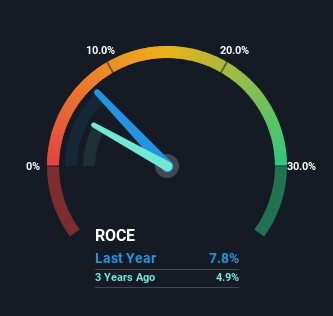Stock Analysis
- United States
- /
- Wireless Telecom
- /
- NasdaqGS:TMUS
Here's What To Make Of T-Mobile US' (NASDAQ:TMUS) Decelerating Rates Of Return

What trends should we look for it we want to identify stocks that can multiply in value over the long term? Amongst other things, we'll want to see two things; firstly, a growing return on capital employed (ROCE) and secondly, an expansion in the company's amount of capital employed. Basically this means that a company has profitable initiatives that it can continue to reinvest in, which is a trait of a compounding machine. Having said that, from a first glance at T-Mobile US (NASDAQ:TMUS) we aren't jumping out of our chairs at how returns are trending, but let's have a deeper look.
Return On Capital Employed (ROCE): What Is It?
Just to clarify if you're unsure, ROCE is a metric for evaluating how much pre-tax income (in percentage terms) a company earns on the capital invested in its business. Analysts use this formula to calculate it for T-Mobile US:
Return on Capital Employed = Earnings Before Interest and Tax (EBIT) ÷ (Total Assets - Current Liabilities)
0.078 = US$14b ÷ (US$209b - US$22b) (Based on the trailing twelve months to September 2023).
So, T-Mobile US has an ROCE of 7.8%. In absolute terms, that's a low return and it also under-performs the Wireless Telecom industry average of 16%.
View our latest analysis for T-Mobile US

Above you can see how the current ROCE for T-Mobile US compares to its prior returns on capital, but there's only so much you can tell from the past. If you'd like to see what analysts are forecasting going forward, you should check out our free report for T-Mobile US.
The Trend Of ROCE
The returns on capital haven't changed much for T-Mobile US in recent years. The company has employed 203% more capital in the last five years, and the returns on that capital have remained stable at 7.8%. This poor ROCE doesn't inspire confidence right now, and with the increase in capital employed, it's evident that the business isn't deploying the funds into high return investments.
In Conclusion...
As we've seen above, T-Mobile US' returns on capital haven't increased but it is reinvesting in the business. Investors must think there's better things to come because the stock has knocked it out of the park, delivering a 133% gain to shareholders who have held over the last five years. However, unless these underlying trends turn more positive, we wouldn't get our hopes up too high.
Like most companies, T-Mobile US does come with some risks, and we've found 3 warning signs that you should be aware of.
While T-Mobile US may not currently earn the highest returns, we've compiled a list of companies that currently earn more than 25% return on equity. Check out this free list here.
Valuation is complex, but we're here to simplify it.
Discover if T-Mobile US might be undervalued or overvalued with our detailed analysis, featuring fair value estimates, potential risks, dividends, insider trades, and its financial condition.
Access Free AnalysisHave feedback on this article? Concerned about the content? Get in touch with us directly. Alternatively, email editorial-team (at) simplywallst.com.
This article by Simply Wall St is general in nature. We provide commentary based on historical data and analyst forecasts only using an unbiased methodology and our articles are not intended to be financial advice. It does not constitute a recommendation to buy or sell any stock, and does not take account of your objectives, or your financial situation. We aim to bring you long-term focused analysis driven by fundamental data. Note that our analysis may not factor in the latest price-sensitive company announcements or qualitative material. Simply Wall St has no position in any stocks mentioned.
About NasdaqGS:TMUS
T-Mobile US
Provides mobile communications services in the United States, Puerto Rico, and the United States Virgin Islands.
Solid track record and fair value.

